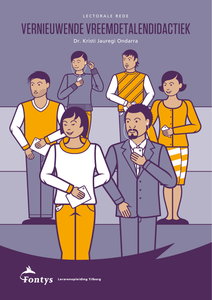Verschenen in Levende Talen Tijdschrift, 16 (2), 3-15. 2015
LINK
Openbare les Prof. Dr. Rick de Graaff, 24 mei 2018
DOCUMENT

De snel veranderende maatschappij en de digitalisering en globalisering ervan vragen van opleiders en docenten nieuwe inzichten, kennis en vaardigheden. Docentenopleidingen dragen de maatschappelijke en professionele verantwoordelijkheid om vakdidactische digitale innovatie naar, in dit geval, taal- en cultuuronderwijs, te initiëren, te begeleiden en te evalueren. Binnen dit lectoraat wordt onderzoek verricht naar innoverend en effectief taal- en cultuuronderwijs en naar effectief onderwijs over taalonderwijs bij de lerarenopleiding. Er wordt gekeken naar de rol die nieuwe media kunnen spelen in het optimaliseren van betekenisvolle leerprocessen. Welke toepassingen zijn beschikbaar voor het vreemdetalenonderwijs? Hoe kunnen die zinvol gebruikt worden? Welke didactiek hier hierbij? Wat zijn de rollen van opleiders, docenten en studenten? Wat zijn de kenmerken van effectieve werkvormen en taken die betekenisvolle leerprocessen bevorderen? De onderzoeksopbrengsten worden vertaald naar het talenonderwijs van de lerarenopleiding én het voortgezet onderwijs. Bovendien zullen deze resultaten bijdragen aan een sterke vakdidactische kennisbasis en docentcompetenties en aan een onderzoekende en innovatieve houding van opleiders, leraren in het veld en studenten in de snel veranderende educatieve sector. Dit impliceert een levenlang leren.
DOCUMENT

Een meertalige aanpak – die ruimte biedt aan alle thuistalen – kan ons onderwijs toegankelijker, rijker en eerlijker maken. Toegankelijker, omdat zo’n aanpak meertalige leerlingen in staat stelt om volledig mee te doen in ons onderwijs, en gebruik te maken van kennis en vaardigheden die zij in andere talen dan het Nederlands hebben ontwikkeld. Daarnaast zullen ouders-verzorgers makkelijker hun weg vinden naar het Nederlandse onderwijs, net zoals het onderwijs naar hen, en zullen ouders-verzorgers hun kinderen beter kunnen ondersteunen. Rijker, in de eerste plaats, omdat meertaligen zich meer gezien en gehoord voelen wanneer hun thuistaal welkom is in ons onderwijs en omdat we daarmee allemaal meer te zien en te horen krijgen van de diverse wereld om ons heen. Rijker, in de tweede plaats, wanneer thuistalen een plek krijgen in betekenisvol, interactief en taalondersteunend onderwijs, waarin deeltaalvaardigheden (zoals lezen, spreken en schrijven) én vakinhoudelijke kennis (van primair tot hoger onderwijs) niet afzonderlijk maar in samenhang met elkaar worden ontwikkeld. Eerlijker, tot slot, omdat ruimte voor thuistalen bijdraagt aan gelijkere onderwijskansen en uiteindelijk dus ook bevorderlijk is voor passende doorstroom tussen onderwijssectoren en van school naar werk.
DOCUMENT

Leerlingen die hun hele schoolcarrière goede cijfers hebben gehaald voor vreemde talen, zoals Frans, Duits of Spaans, blijken vaak niet goed in staat om in die talen te communiceren. Kennelijk is er iets anders getoetst dan communicatievaardigheid. Als de toetsing zich daar beter op richt, welke effecten heeft dat dan op de onderwijsactiviteiten? Deze vraag staat centraal in het promotieonderzoek van Charline Rouffet.
LINK
Leerlingen die hun hele schoolcarrière goede cijfers hebben gehaald voor vreemde talen, zoals Frans, Duits of Spaans, blijken vaak niet goed in staat om in die talen te communiceren. Kennelijk is er iets anders getoetst dan communicatievaardigheid. Als de toetsing zich daar beter op richt, welke effecten heeft dat dan op de onderwijsactiviteiten? Deze vraag staat centraal in het promotieonderzoek van Charline Rouffet.
MULTIFILE
Across the globe, linguistically heterogeneous populations increasingly define school systems at the same time that developing the ability to communicate cross-culturally is becoming essential for internationalized economies. While these trends seem complimentary, they often appear in paradoxical opposition as represented in the content and execution of nationwide education policies. Given the differing geopolitical contexts within which school systems function, wide variation exists with regard to how policymakers address the challenges of providing language education, including how they frame goals and design programs to align with those goals. Here we present a cross-continental examination of this variation, which reveals parallel tensions among aims for integrating immigrant populations, closing historic achievement gaps, fostering intercultural understanding, and developing multilingual competencies. To consider implications of such paradoxes and parallels in policy foundations, we compare language education in the US and in the EU, focusing on the Netherlands as an illustrative case study.
LINK
Liz is a CLIL and language teacher educator, senior lecturer, author, and researcher. Her publications include CLIL Skills, CLIL Activities, a doctoral thesis on the role of English teachers in bilingual streams and articles on multilingualism. She also chairs audit panels for bilingual streams in vocational and academic tracks. You will be introduced to a visual methodology as a way of uncovering learners’ multilingual experiences. Language mapping is a technique that helps learners uncover their own lived multilingual experiences and to represent and talk about these using their own words and descriptions. Liz Dale will show you how and why language mapping works and how you can integrate this exercise in a lesson. Of course, you will try your hand at creating your own language map!
DOCUMENT

Communicatieve leerdoelen die op landelijk niveau opgenomen zijn in de eindtermen voor de moderne vreemde talen worden niet altijd weerspiegeld in de dagelijkse les- en toetspraktijken. Omdat in een curriculum samenhang tussen leerdoelen, leeractiviteiten en toetsing (‘constructive alignment’) een voorwaarde is voor effectief onderwijs, is het van belang om inzicht te krijgen in (oorzaken van) een mogelijk gebrek daaraan. Charline Rouffet, Catherine van Beuningen en Rick de Graaff onderzochten de mate van samenhang in vreemdetalencurricula tussen leerdoelen, leeractiviteiten en toetsing, en de factoren die daarop van invloed kunnen zijn. Uit de resultaten blijkt dat leeractiviteiten en toetsing voornamelijk gericht zijn op kennis van grammaticaregels en woordenschat zonder toepassing in de praktijk, en op leesvaardigheid. Externe factoren, zoals beschikbaar les- en toetsmateriaal, en conceptuele factoren, zoals opvattingen van docenten over het leren van talen, blijken bij te dragen aan dit gebrek aan samenhang. Toetsing die niet in lijn is met de communicatieve leerdoelen heeft met name een negatief sturend effect op leeractiviteiten, en daarmee op de implementatie van effectief communicatief vreemdetalenonderwijs in de praktijk.
MULTIFILE